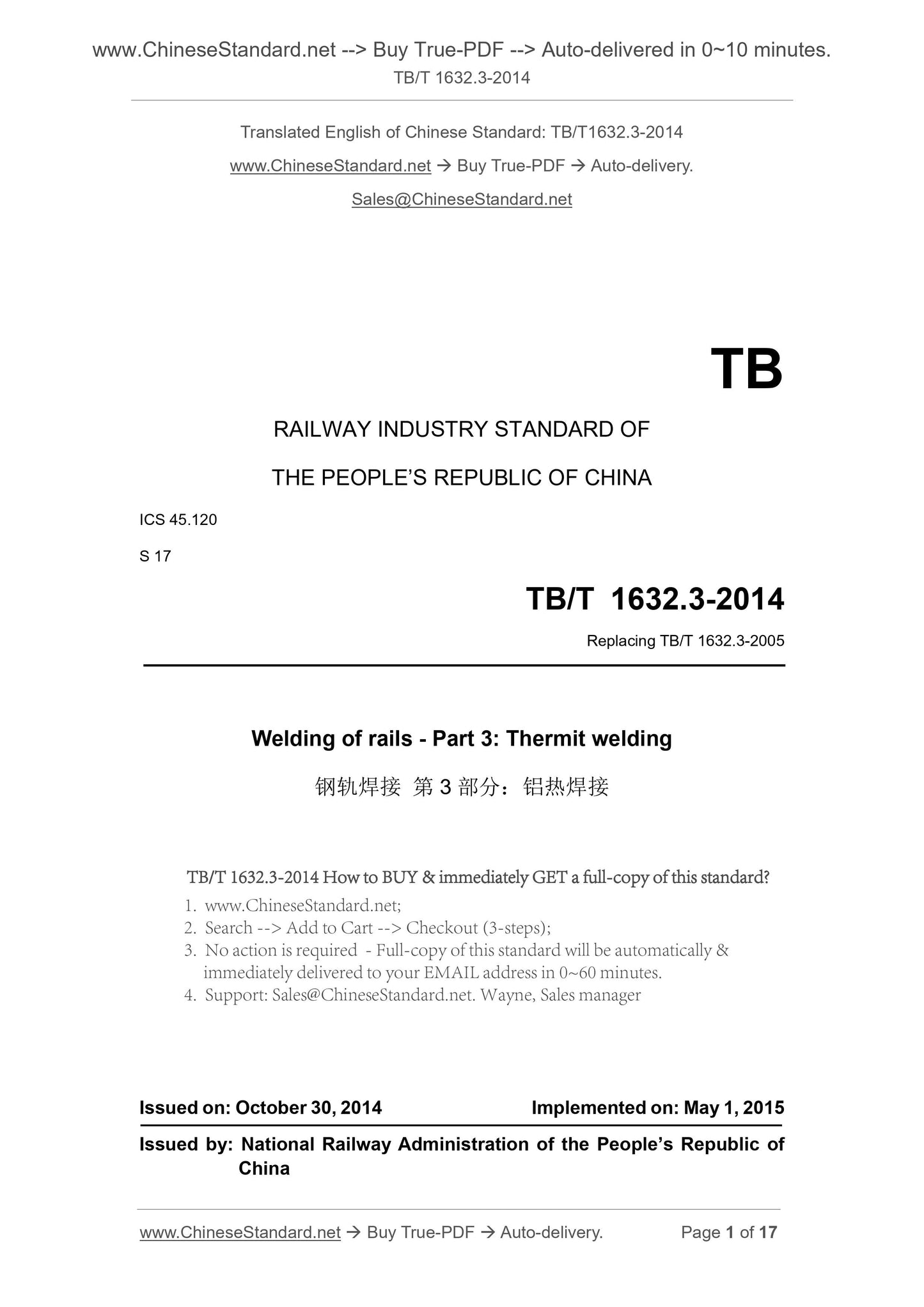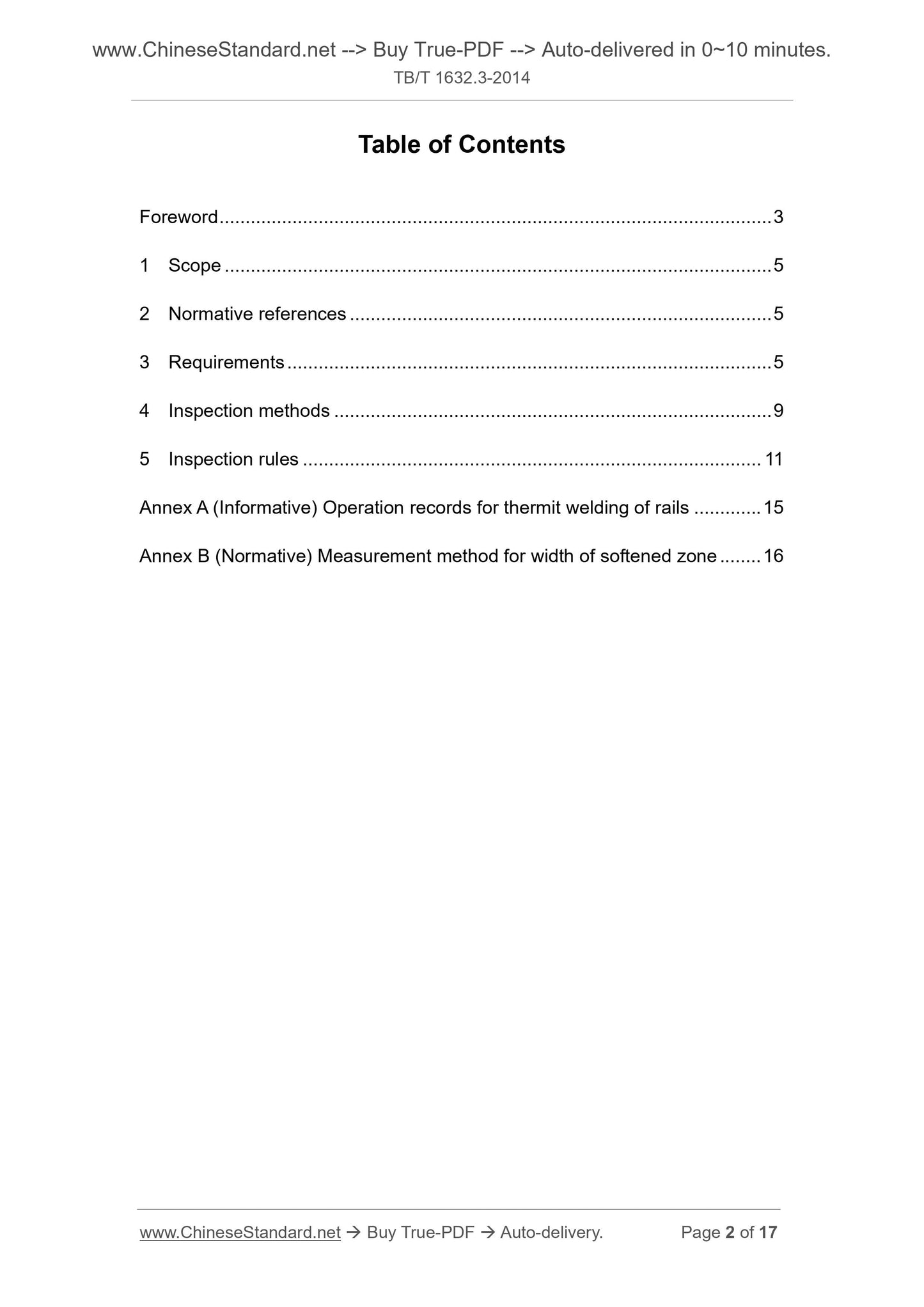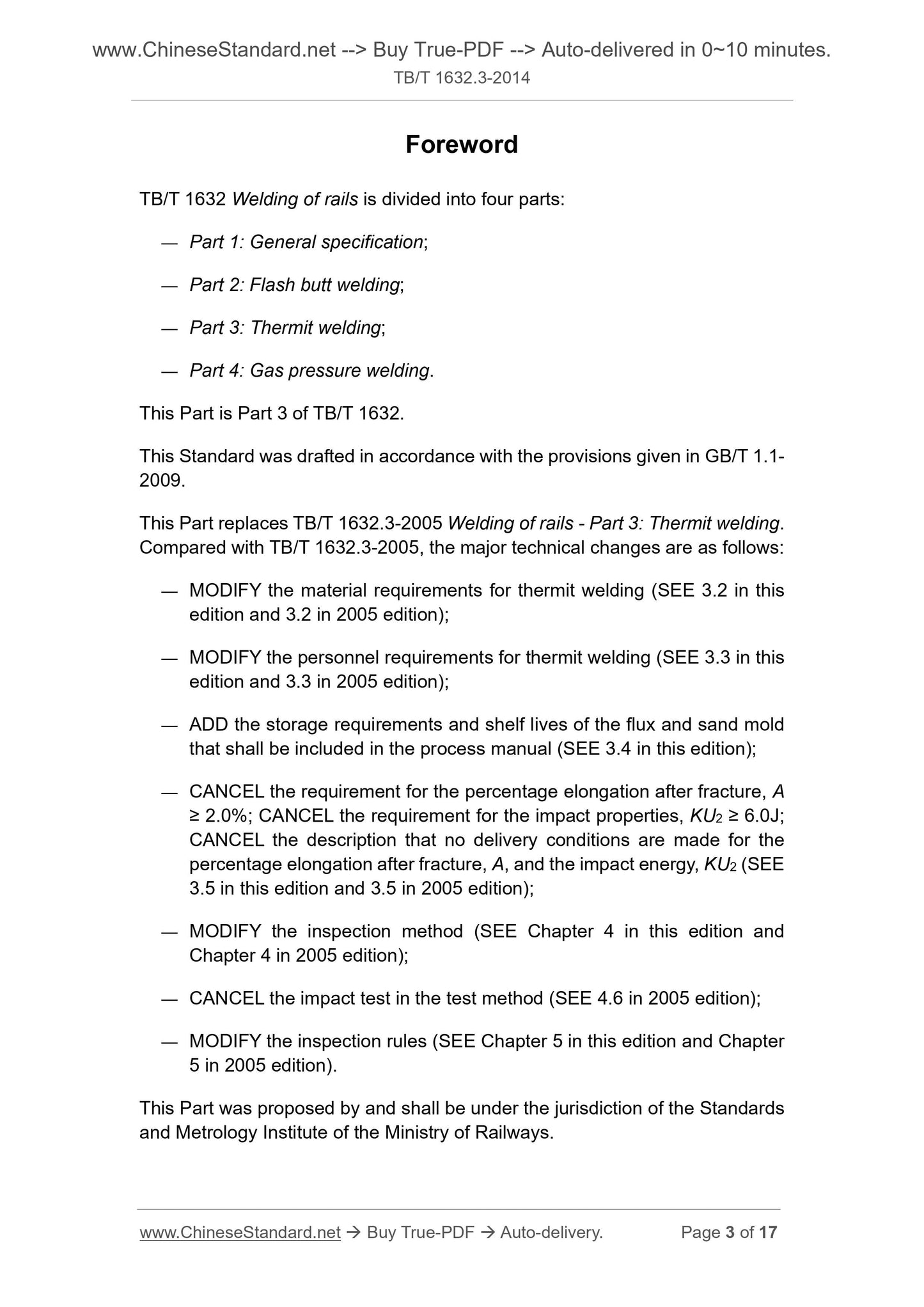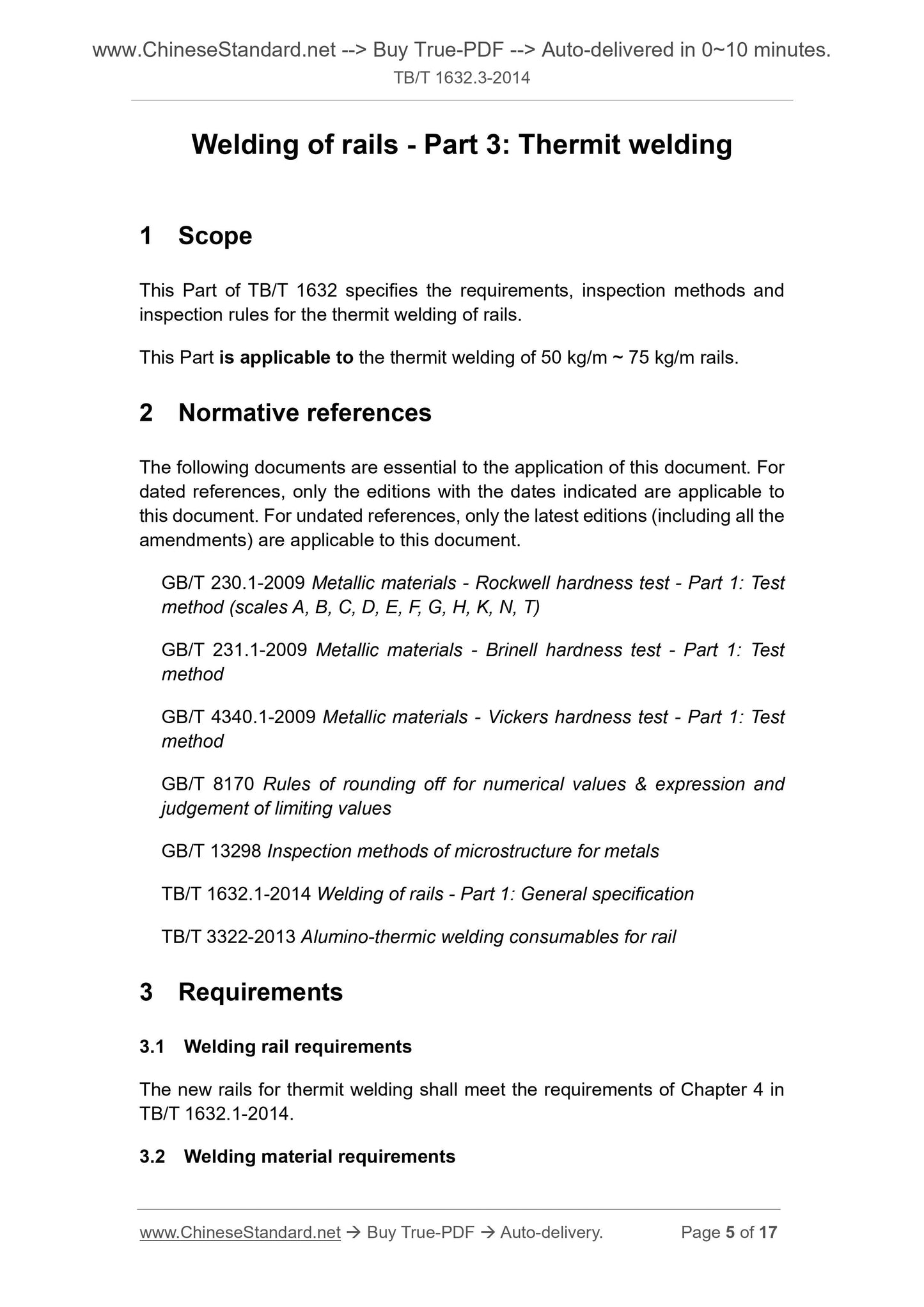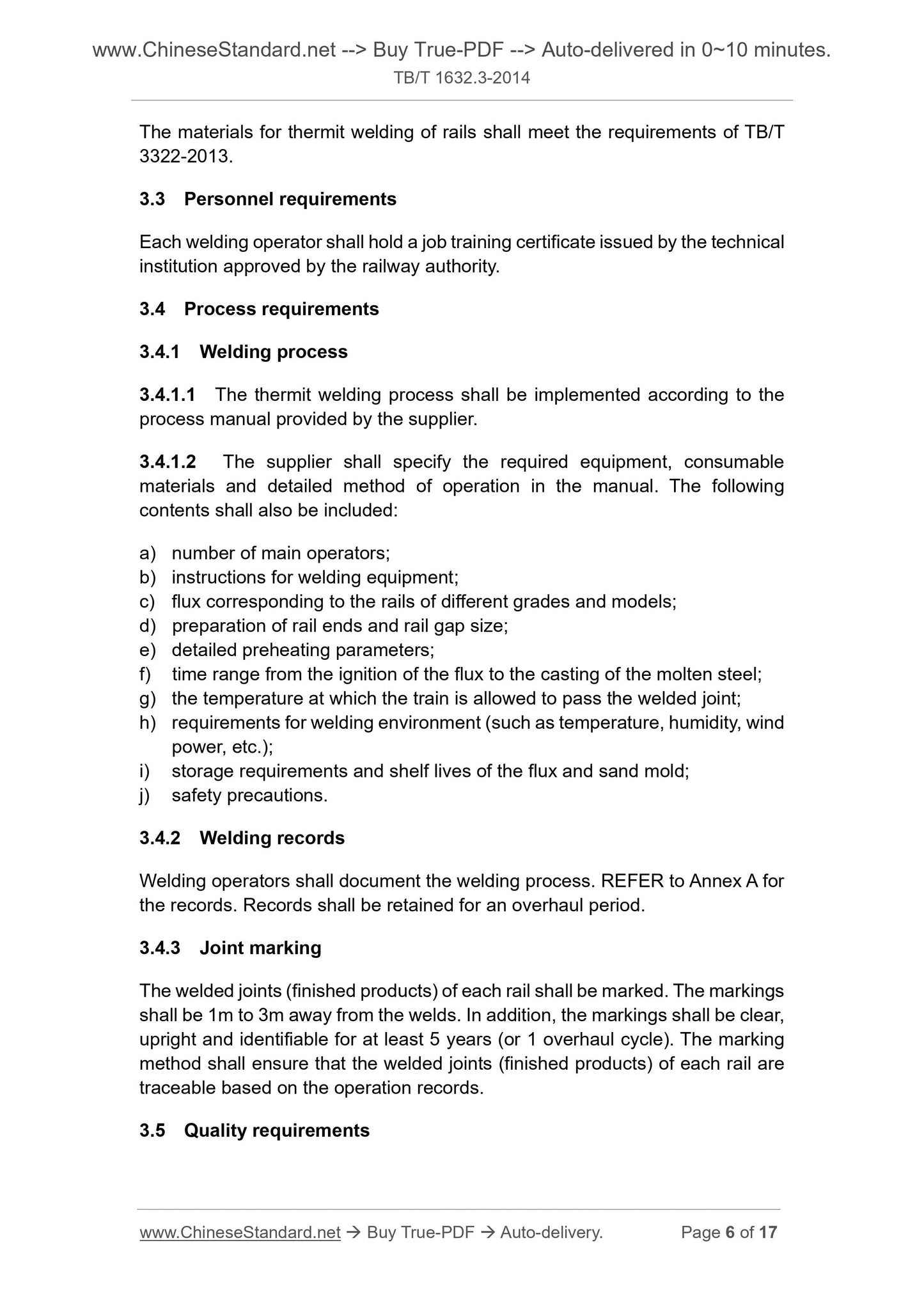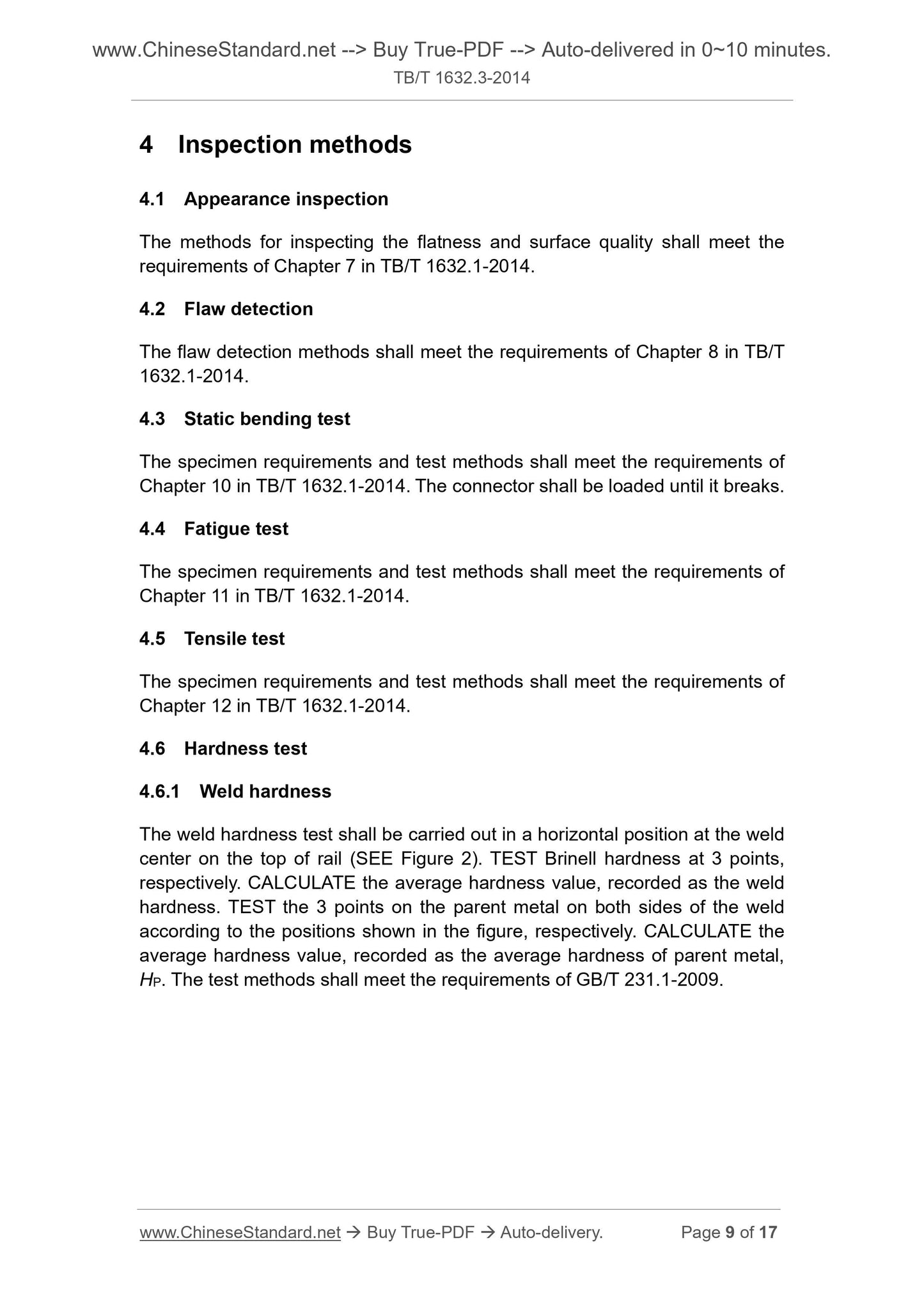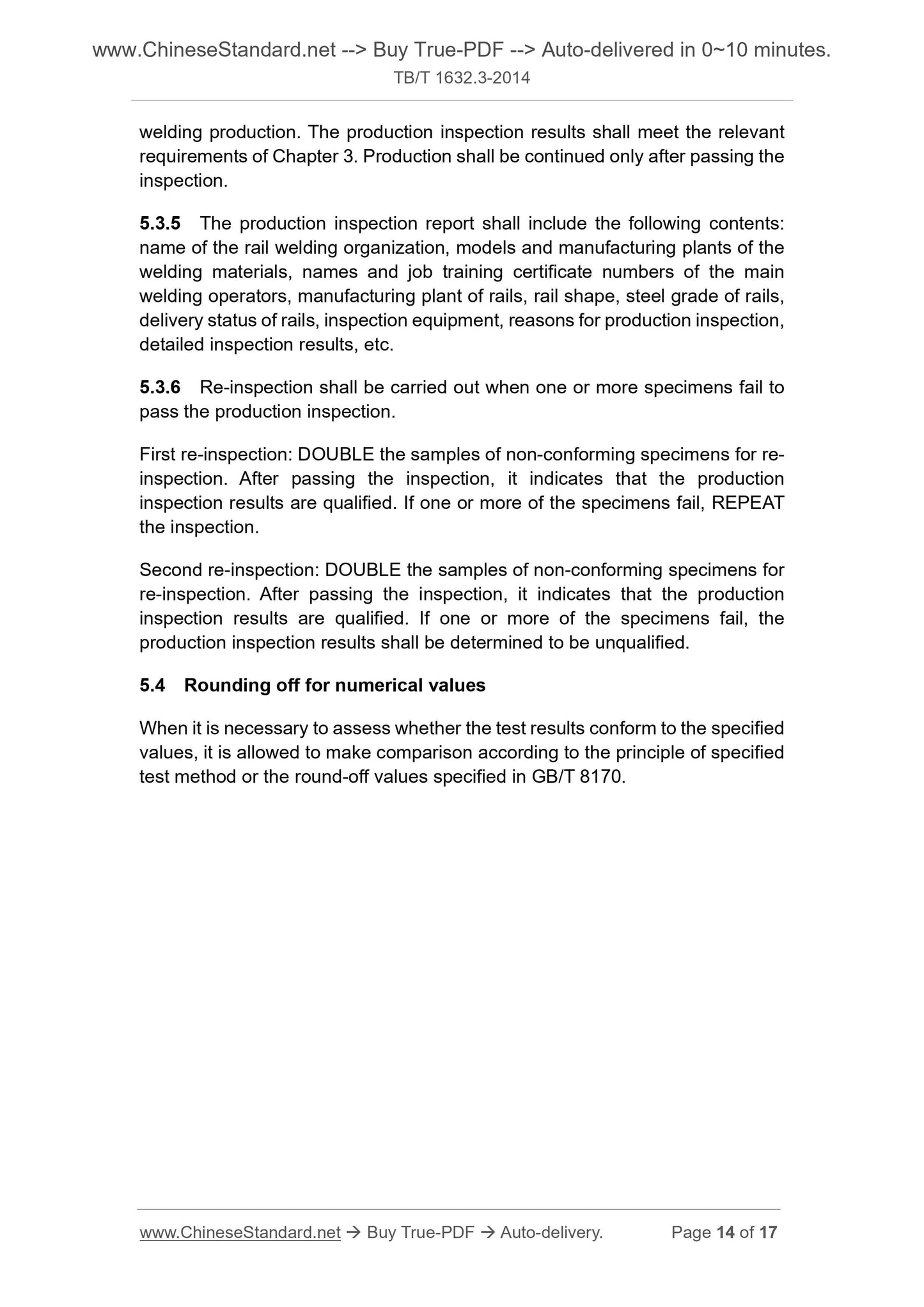1
/
of
7
PayPal, credit cards. Download editable-PDF and invoice in 1 second!
TB/T 1632.3-2014 English PDF (TBT1632.3-2014)
TB/T 1632.3-2014 English PDF (TBT1632.3-2014)
Regular price
$140.00 USD
Regular price
Sale price
$140.00 USD
Unit price
/
per
Shipping calculated at checkout.
Couldn't load pickup availability
Delivery: 3 seconds. Download true-PDF + Invoice.
Get QUOTATION in 1-minute: Click TB/T 1632.3-2014
Historical versions: TB/T 1632.3-2014
Preview True-PDF (Reload/Scroll if blank)
TB/T 1632.3-2014: Welding of rails - Part 3: Thermit welding
TB/T 1632.3-2014
TB
RAILWAY INDUSTRY STANDARD OF
THE PEOPLE’S REPUBLIC OF CHINA
ICS 45.120
S 17
Replacing TB/T 1632.3-2005
Welding of rails - Part 3. Thermit welding
ISSUED ON. OCTOBER 30, 2014
IMPLEMENTED ON. MAY 1, 2015
Issued by. National Railway Administration of the People’s Republic of
China
Table of Contents
Foreword ... 3
1 Scope ... 5
2 Normative references ... 5
3 Requirements ... 5
4 Inspection methods ... 9
5 Inspection rules ... 11
Annex A (Informative) Operation records for thermit welding of rails ... 15
Annex B (Normative) Measurement method for width of softened zone ... 16
Foreword
TB/T 1632 Welding of rails is divided into four parts.
— Part 1. General specification;
— Part 2. Flash butt welding;
— Part 3. Thermit welding;
— Part 4. Gas pressure welding.
This Part is Part 3 of TB/T 1632.
This Standard was drafted in accordance with the provisions given in GB/T 1.1-
2009.
This Part replaces TB/T 1632.3-2005 Welding of rails - Part 3. Thermit welding.
Compared with TB/T 1632.3-2005, the major technical changes are as follows.
— MODIFY the material requirements for thermit welding (SEE 3.2 in this
edition and 3.2 in 2005 edition);
— MODIFY the personnel requirements for thermit welding (SEE 3.3 in this
edition and 3.3 in 2005 edition);
— ADD the storage requirements and shelf lives of the flux and sand mold
that shall be included in the process manual (SEE 3.4 in this edition);
— CANCEL the requirement for the percentage elongation after fracture, A
≥ 2.0%; CANCEL the requirement for the impact properties, KU2 ≥ 6.0J;
CANCEL the description that no delivery conditions are made for the
percentage elongation after fracture, A, and the impact energy, KU2 (SEE
3.5 in this edition and 3.5 in 2005 edition);
— MODIFY the inspection method (SEE Chapter 4 in this edition and
Chapter 4 in 2005 edition);
— CANCEL the impact test in the test method (SEE 4.6 in 2005 edition);
— MODIFY the inspection rules (SEE Chapter 5 in this edition and Chapter
5 in 2005 edition).
This Part was proposed by and shall be under the jurisdiction of the Standards
and Metrology Institute of the Ministry of Railways.
Welding of rails - Part 3. Thermit welding
1 Scope
This Part of TB/T 1632 specifies the requirements, inspection methods and
inspection rules for the thermit welding of rails.
This Part is applicable to the thermit welding of 50 kg/m ~ 75 kg/m rails.
2 Normative references
The following documents are essential to the application of this document. For
dated references, only the editions with the dates indicated are applicable to
this document. For undated references, only the latest editions (including all the
amendments) are applicable to this document.
GB/T 230.1-2009 Metallic materials - Rockwell hardness test - Part 1. Test
method (scales A, B, C, D, E, F, G, H, K, N, T)
GB/T 231.1-2009 Metallic materials - Brinell hardness test - Part 1. Test
method
GB/T 4340.1-2009 Metallic materials - Vickers hardness test - Part 1. Test
method
GB/T 8170 Rules of rounding off for numerical values and expression and
judgement of limiting values
GB/T 13298 Inspection methods of microstructure for metals
TB/T 1632.1-2014 Welding of rails - Part 1. General specification
TB/T 3322-2013 Alumino-thermic welding consumables for rail
3 Requirements
3.1 Welding rail requirements
The new rails for thermit welding shall meet the requirements of Chapter 4 in
TB/T 1632.1-2014.
3.2 Welding material requirements
The materials for thermit welding of rails shall meet the requirements of TB/T
3322-2013.
3.3 Personnel requirements
Each welding operator shall hold a job training certificate issued by the technical
institution approved by the railway authority.
3.4 Process requirements
3.4.1 Welding process
3.4.1.1 The thermit welding process shall be implemented according to the
process manual provided by the supplier.
3.4.1.2 The supplier shall specify the required equipment, consumable
materials and detailed method of operation in the manual. The following
contents shall also be included.
a) number of main operators;
b) instructions for welding equipment;
c) flux corresponding to the rails of different grades and models;
d) preparation of rail ends and rail gap size;
e) detailed preheating parameters;
f) time range from the ignition of the flux to the casting of the molten steel;
g) the temperature at which the train is allowed to pass the welded joint;
h) requirements for welding environment (such as temperature, humidity, wind
power, etc.);
i) storage requirements and shelf lives of the flux and sand mold;
j) safety precautions.
3.4.2 Welding records
Welding operators shall document the welding process. REFER to Annex A for
the records. Records shall be retained for an overhaul period.
3.4.3 Joint marking
The welded joints (finished products) of each rail shall be marked. The markings
shall be 1m to 3m away from the welds. In addition, the markings shall be clear,
upright and identifiable for at least 5 years (or 1 overhaul cycle). The marking
method shall ensure that the welded joints (finished products) of each rail are
traceable based on the operation records.
3.5 Quality requirements
4 Inspection methods
4.1 Appearance inspection
The methods for inspecting the flatness and surface quality shall meet the
requirements of Chapter 7 in TB/T 1632.1-2014.
4.2 Flaw detection
The flaw detection methods shall meet the requirements of Chapter 8 in TB/T
1632.1-2014.
4.3 Static bending test
The specimen requirements and test methods shall meet the requirements of
Chapter 10 in TB/T 1632.1-2014. The connector shall be loaded until it breaks.
4.4 Fatigue test
The specimen requirements and test methods shall meet the requirements of
Chapter 11 in TB/T 1632.1-2014.
4.5 Tensile test
The specimen requirements and test methods shall meet the requirements of
Chapter 12 in TB/T 1632.1-2014.
4.6 Hardness test
4.6.1 Weld hardness
The weld hardness test shall be carried out in a horizontal position at the weld
center on the top of rail (SEE Figure 2). TEST Brinell hardness at 3 points,
respectively. CALCULATE the average hardness value, recorded as the weld
hardness. TEST the 3 points on the parent metal on both sides of the weld
according to the positions shown in the figure, respectively. CALCULATE the
average hardness value, recorded as the average hardness of parent metal,
HP. The test methods shall meet the requirements of GB/T 231.1-2009.
welding production. The production inspection results shall meet the relevant
requirements of Chapter 3. Production shall be continued only after passing the
inspection.
5.3.5 The production inspection report shall include the following contents.
name of the rail welding organization, models and manufacturing plants of the
welding materials, names and job training certificate numbers of the main
welding operators, manufacturing plant of rails, rail shape, steel grade of rails,
delivery status of rails, inspection equipment, reasons for production inspection,
detailed inspection results, etc.
5.3.6 Re-inspection shall be carried out when one or more specimens fail to
pass the production inspection.
First re-inspection. DOUBLE the samples of non-conforming specimens for re-
inspection. After passing the inspection, it indicates that the pro...
Get QUOTATION in 1-minute: Click TB/T 1632.3-2014
Historical versions: TB/T 1632.3-2014
Preview True-PDF (Reload/Scroll if blank)
TB/T 1632.3-2014: Welding of rails - Part 3: Thermit welding
TB/T 1632.3-2014
TB
RAILWAY INDUSTRY STANDARD OF
THE PEOPLE’S REPUBLIC OF CHINA
ICS 45.120
S 17
Replacing TB/T 1632.3-2005
Welding of rails - Part 3. Thermit welding
ISSUED ON. OCTOBER 30, 2014
IMPLEMENTED ON. MAY 1, 2015
Issued by. National Railway Administration of the People’s Republic of
China
Table of Contents
Foreword ... 3
1 Scope ... 5
2 Normative references ... 5
3 Requirements ... 5
4 Inspection methods ... 9
5 Inspection rules ... 11
Annex A (Informative) Operation records for thermit welding of rails ... 15
Annex B (Normative) Measurement method for width of softened zone ... 16
Foreword
TB/T 1632 Welding of rails is divided into four parts.
— Part 1. General specification;
— Part 2. Flash butt welding;
— Part 3. Thermit welding;
— Part 4. Gas pressure welding.
This Part is Part 3 of TB/T 1632.
This Standard was drafted in accordance with the provisions given in GB/T 1.1-
2009.
This Part replaces TB/T 1632.3-2005 Welding of rails - Part 3. Thermit welding.
Compared with TB/T 1632.3-2005, the major technical changes are as follows.
— MODIFY the material requirements for thermit welding (SEE 3.2 in this
edition and 3.2 in 2005 edition);
— MODIFY the personnel requirements for thermit welding (SEE 3.3 in this
edition and 3.3 in 2005 edition);
— ADD the storage requirements and shelf lives of the flux and sand mold
that shall be included in the process manual (SEE 3.4 in this edition);
— CANCEL the requirement for the percentage elongation after fracture, A
≥ 2.0%; CANCEL the requirement for the impact properties, KU2 ≥ 6.0J;
CANCEL the description that no delivery conditions are made for the
percentage elongation after fracture, A, and the impact energy, KU2 (SEE
3.5 in this edition and 3.5 in 2005 edition);
— MODIFY the inspection method (SEE Chapter 4 in this edition and
Chapter 4 in 2005 edition);
— CANCEL the impact test in the test method (SEE 4.6 in 2005 edition);
— MODIFY the inspection rules (SEE Chapter 5 in this edition and Chapter
5 in 2005 edition).
This Part was proposed by and shall be under the jurisdiction of the Standards
and Metrology Institute of the Ministry of Railways.
Welding of rails - Part 3. Thermit welding
1 Scope
This Part of TB/T 1632 specifies the requirements, inspection methods and
inspection rules for the thermit welding of rails.
This Part is applicable to the thermit welding of 50 kg/m ~ 75 kg/m rails.
2 Normative references
The following documents are essential to the application of this document. For
dated references, only the editions with the dates indicated are applicable to
this document. For undated references, only the latest editions (including all the
amendments) are applicable to this document.
GB/T 230.1-2009 Metallic materials - Rockwell hardness test - Part 1. Test
method (scales A, B, C, D, E, F, G, H, K, N, T)
GB/T 231.1-2009 Metallic materials - Brinell hardness test - Part 1. Test
method
GB/T 4340.1-2009 Metallic materials - Vickers hardness test - Part 1. Test
method
GB/T 8170 Rules of rounding off for numerical values and expression and
judgement of limiting values
GB/T 13298 Inspection methods of microstructure for metals
TB/T 1632.1-2014 Welding of rails - Part 1. General specification
TB/T 3322-2013 Alumino-thermic welding consumables for rail
3 Requirements
3.1 Welding rail requirements
The new rails for thermit welding shall meet the requirements of Chapter 4 in
TB/T 1632.1-2014.
3.2 Welding material requirements
The materials for thermit welding of rails shall meet the requirements of TB/T
3322-2013.
3.3 Personnel requirements
Each welding operator shall hold a job training certificate issued by the technical
institution approved by the railway authority.
3.4 Process requirements
3.4.1 Welding process
3.4.1.1 The thermit welding process shall be implemented according to the
process manual provided by the supplier.
3.4.1.2 The supplier shall specify the required equipment, consumable
materials and detailed method of operation in the manual. The following
contents shall also be included.
a) number of main operators;
b) instructions for welding equipment;
c) flux corresponding to the rails of different grades and models;
d) preparation of rail ends and rail gap size;
e) detailed preheating parameters;
f) time range from the ignition of the flux to the casting of the molten steel;
g) the temperature at which the train is allowed to pass the welded joint;
h) requirements for welding environment (such as temperature, humidity, wind
power, etc.);
i) storage requirements and shelf lives of the flux and sand mold;
j) safety precautions.
3.4.2 Welding records
Welding operators shall document the welding process. REFER to Annex A for
the records. Records shall be retained for an overhaul period.
3.4.3 Joint marking
The welded joints (finished products) of each rail shall be marked. The markings
shall be 1m to 3m away from the welds. In addition, the markings shall be clear,
upright and identifiable for at least 5 years (or 1 overhaul cycle). The marking
method shall ensure that the welded joints (finished products) of each rail are
traceable based on the operation records.
3.5 Quality requirements
4 Inspection methods
4.1 Appearance inspection
The methods for inspecting the flatness and surface quality shall meet the
requirements of Chapter 7 in TB/T 1632.1-2014.
4.2 Flaw detection
The flaw detection methods shall meet the requirements of Chapter 8 in TB/T
1632.1-2014.
4.3 Static bending test
The specimen requirements and test methods shall meet the requirements of
Chapter 10 in TB/T 1632.1-2014. The connector shall be loaded until it breaks.
4.4 Fatigue test
The specimen requirements and test methods shall meet the requirements of
Chapter 11 in TB/T 1632.1-2014.
4.5 Tensile test
The specimen requirements and test methods shall meet the requirements of
Chapter 12 in TB/T 1632.1-2014.
4.6 Hardness test
4.6.1 Weld hardness
The weld hardness test shall be carried out in a horizontal position at the weld
center on the top of rail (SEE Figure 2). TEST Brinell hardness at 3 points,
respectively. CALCULATE the average hardness value, recorded as the weld
hardness. TEST the 3 points on the parent metal on both sides of the weld
according to the positions shown in the figure, respectively. CALCULATE the
average hardness value, recorded as the average hardness of parent metal,
HP. The test methods shall meet the requirements of GB/T 231.1-2009.
welding production. The production inspection results shall meet the relevant
requirements of Chapter 3. Production shall be continued only after passing the
inspection.
5.3.5 The production inspection report shall include the following contents.
name of the rail welding organization, models and manufacturing plants of the
welding materials, names and job training certificate numbers of the main
welding operators, manufacturing plant of rails, rail shape, steel grade of rails,
delivery status of rails, inspection equipment, reasons for production inspection,
detailed inspection results, etc.
5.3.6 Re-inspection shall be carried out when one or more specimens fail to
pass the production inspection.
First re-inspection. DOUBLE the samples of non-conforming specimens for re-
inspection. After passing the inspection, it indicates that the pro...
Share
